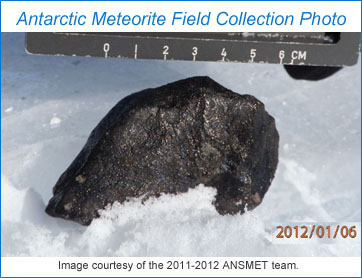ANSMET 2011-2012 Field Season in the Miller Range, Antarctica
 |
The 2011-2012 ANSMET field party:
- Ralph Harvey* (Principal Investigator of ANSMET, Case Western Reserve University)
- Jesper Holst (University of Copenhagen)
- Katie Joy (Lunar and Planetary Institute, Houston)
- Jim Karner* (Post-Doctoral Researcher of ANSMET, Case Western Reserve University)
- Jake Maule (Carnegie Institution of Washington)
- Anne Peslier (NASA Johnson Space Center)
- Christian Schrader (NASA Marshall Space Flight Center)
- John Schutt* (Science lead and safety officer of ANSMET, Case Western Reserve University)
- Tim Swindle* (University of Arizona)
Veterans of previous seasons are marked with an asterisk(*). |
The Antarctic Search for Meteorites (ANSMET) 2011-2012 season is a wrap and 302 meteorites are heading north by ship from McMurdo Station. The ANSMET team searched the Miller Range icefields in the Transantarctic Mountains in their coordinated red-parka fashion, collecting enough specimens to reach the 20,000 milestone for meteorites recovered by ANSMET since 1976, when the expeditions began. Ralph Harvey (Case Western Reserve University), the Principal Investigator of ANSMET, describes the icefields in the Miller Range "amazingly productive sites" in terms of unusual specimens. Tim Swindle, a four-time veteran ANSMETer and cosmochemist from the University of Arizona, explains one of the draws of Antarctica that keeps him returning, "Waking up to Antarctic quiet on a windless day. The only sound is the ice cap popping beneath you as it flows along on its millennia long march to the sea." He and all ANSMET team members share the thrill of knowing that sometime during the season, they are probably the first people to set foot on that spot on the planet and certainly the first people to see the rocks from space. Though the working conditions are difficult, the location is spectacular, and the meteorites bagged by season's end are the prizes well won. ANSMET is a U.S.-funded cooperative effort among the National Science Foundation (NSF-Office of Polar Programs), NASA, and the Smithsonian Institution. NSF provides support for field research and collection. NASA and the Smithsonian Institution share the responsibilities of classifying, storing, and distributing Antarctic meteorites to researchers around the globe. This website at the NASA Johnson Space Center discusses curation, characterization, and classification of the ANSMET meteorites:
curator.jsc.nasa.gov/antmet/index.cfm. That's also the site to visit if you are a qualified scientist wishing to request a meteorite for scientific study.
 (pdf version)
(pdf version)
For more information see: NASA's Curation of Antarctic Meteorites, the ANSMET website, the 2011-2012 ANSMET team blog, the February 2012 Antarctic Meteorite Newsletter, and the
PSRD articles
Meteorites on Ice and Searching Antarctic Ice for Meteorites.
Added March, 2015:
NEW BOOK: 35 Seasons of U.S. Antarctic Meteorites (1976-2010): A Pictorial Guide to the Collection, edited by K. Righter, C. Corrigan, T. McCoy, and R. Harvey, American Geophysical Union and John Wiley & Sons, Inc., December 2014, 320 pages.
Written by Linda Martel, Hawai'i Institute of Geophysics and Planetology, for
PSRD.

![]() (pdf version)
(pdf version)
